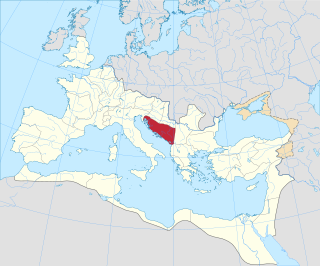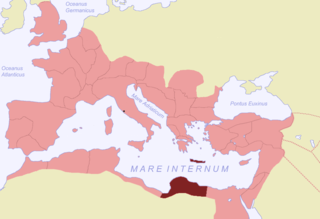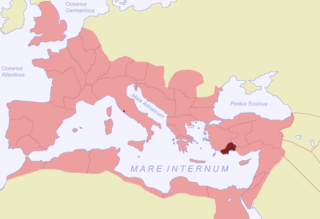Related Research Articles

The gens Atilia, sometimes written Atillia, was a plebeian family at ancient Rome, which rose to prominence at the beginning of the fourth century BC. The first member of this gens to attain the consulship was Marcus Atilius Regulus, in 335 BC. The Atilii continued to hold the highest offices of the state throughout the history of the Republic, and well into imperial times.

Germania Superior was an imperial province of the Roman Empire. It comprised an area of today's western Switzerland, the French Jura and Alsace regions, and southwestern Germany. Important cities were Besançon (Vesontio), Strasbourg (Argentoratum), Wiesbaden, and Germania Superior's capital, Mainz (Mogontiacum). It comprised the Middle Rhine, bordering on the Limes Germanicus, and on the Alpine province of Raetia to the south-east. Although it had been occupied militarily since the reign of Augustus, Germania Superior was not made into an official province until c. 85 AD.

Pannonia Inferior, lit. Lower Pannonia, was a province of the Roman Empire. Its capital was Sirmium. It was one of the border provinces on the Danube. It was formed in the year 103 AD by Emperor Trajan who divided the former province of Pannonia into two parts: Pannonia Superior and Pannonia Inferior. The province included parts of present-day states of Hungary, Serbia, Croatia, and Bosnia and Herzegovina. The province was bordered to the east by a Sarmatian tribe—the Iazyges. Later, the Vandals appeared to the north-east.

Pannonia Superior, lit. Upper Pannonia, was a province of the Roman Empire. Its capital was Carnuntum. It was one on the border provinces on the Danube. It was formed in the year 103 AD by Emperor Trajan who divided the former province of Pannonia into two parts: Pannonia Superior and Pannonia Inferior. The province included parts of present-day states of Austria, Croatia, Hungary, Slovakia, and Slovenia.
The praefectus annonae was a Roman imperial official charged with the supervision of the grain supply to the city of Rome. Under the republic, the job was usually done by an aedile. However, in emergencies, or in times of extraordinary scarcity, an individual would be elected to the office, and would take charge of supplying the entire city with provisions. Lucius Minucius Augurinus, the accuser of Spurius Maelius, was the first individual appointed to this office, serving from 439 BC. During the early 60s BC, following the sacking of the port of Ostia by pirates, Pompey held the powers of the office. Around 7 BC, the first Roman Emperor, Augustus, followed this example, and after vesting himself with these powers, specified that two former praetors should be appointed every year to carry out the functions of this office. Augustus transferred powers from the aedile to this office, and specified that all holders of this office be members of the Equestrian order. Augustus also specified that these officers were to be aided by an adjutor. Later, Augustus specified that these individuals must be of consular rank. After Augustus' reign, one individual would usually hold this office, and this continued until the fall of the Roman Empire.

Dalmatia was a Roman province. Its name is derived from the name of an Illyrian tribe called the Dalmatae, which lived in the central area of the eastern coast of the Adriatic Sea. It encompassed the northern part of present-day Albania, much of Croatia, Bosnia and Herzegovina, Montenegro, Kosovo and Serbia, thus covering an area significantly larger than the current Croatian region of Dalmatia. Originally this region was called Illyria or Illyricum.

Crete and Cyrenaica was a senatorial province of the Roman Empire, established in 67 BC. It comprised the island of Crete and the region of Cyrenaica in present-day Libya.

Lycia et Pamphylia was the name of a province of the Roman empire, located in southern Anatolia. It was created by the emperor Vespasian, who merged Lycia and Pamphylia into a single administrative unit. In 43 AD, the emperor Claudius had annexed Lycia. Pamphylia had been a part of the province of Galatia.
The gens Neratia or Naeratia was a plebeian family at ancient Rome, some of whom subsequently became patricians. The first of the gens to appear in history occur in the time of Augustus, but they did not rise to prominence until the time of Vespasian, when Marcus Neratius Pansa became the first to obtain the consulship. The Neratii married into the Roman imperial family in the fourth century.
Lucius Neratius Priscus was a Roman Senator and leading jurist, serving for a time as the head of the Proculeian school. He was suffect consul in the nundinium of May–June 97 as the colleague of Marcus Annius Verus.
Lucius Neratius Priscus was a Roman senator who held several posts in the emperor's service. He was suffect consul for the nundinium September–December AD 87 as the colleague of Gaius Cilnius Proculus. Priscus is known almost entirely from inscriptions recovered from Saepinum.
Gaius Cilnius Proculus was a Roman senator active during the reign of Domitian. He was suffect consul for the nundinium September–December AD 87 with Lucius Neratius Priscus as his colleague. It is unknown how or if Proculus is related to the better-known Gaius Cilnius Maecenas. Proculus is known only through surviving inscriptions.
